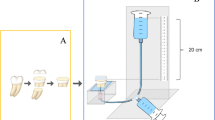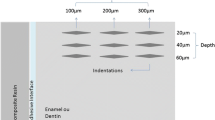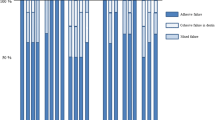Abstract
Objectives
This study evaluated the bond strength of a two-step conventional adhesive system to dentin pretreated with 2.5 % titanium tetrafluoride (TiF4) according to application timing (before or after acid conditioning) and primer/adhesive application method (active or passive).
Materials and methods
Dentin surfaces were randomly treated with different adhesive procedures (n = 6): etching with phosphoric acid (PA) + primer/adhesive (Adper Single Bond 2/3M ESPE) actively applied; PA + primer/adhesive passively applied; TiF4 before PA + primer/adhesive actively applied; TiF4 before PA + primer/adhesive passively applied; TiF4 after PA + primer/adhesive actively applied; and TiF4 after PA + primer/adhesive passively applied. A composite block was built onto the tooth, which was sectioned into sticks (adhesive area of approximately 1 mm2). Microtensile bond strength tests and the failure mode were determined.
Results
Two-way ANOVA revealed no significant interaction between TiF4 application timing and primer/adhesive application method (p = 0.184). The use of TiF4, before or after PA significantly increased bond strength values (p < 0.001). There was no significant difference in bond strength values when using TiF4 before or after PA. The primer/adhesive application method had no influence on bond strength, regardless of whether TiF4 was used (p = 0.906). Failure mode was predominantly adhesive.
Conclusions
The use of TiF4 promoted higher immediate bond strength to dentin. The conventional adhesive system may be applied either actively or passively, regardless of TiF4 application timing.
Clinical significance
Pretreatment with TiF4 increased bond strength in a conventional two-step adhesive system to dentin, regardless of the primer/adhesive application method and the timing of dentin pretreatment.


Similar content being viewed by others
References
Magalhães AC, Comar LP, Rios D, Delbem AC, Buzalaf MA (2008) Effect of a 4% titanium tetrafluoride (TiF4) varnish on demineralisation and remineralisation of bovine enamel in vitro. J Dent 36:158–162
Reed AJ, Bibby BG (1976) Preliminary report on effect of topical applications of titanium tetrafluoride on dental caries. J Dent Res 55:357–358
Büyükyılmaz T, Ogaard B, Duschner H, Ruben J, Arends J (1997) The caries-preventive effect of titanium tetrafluoride on root surfaces in situ as evaluated by microradiography and confocal laser scanning microscopy. Adv Dent Res 11:448–452
Wiegand A, Meier W, Sutter E, Magalhães AC, Becker K, Roos M, Attin T (2008) Protective effect of different tetrafluorides on erosion of pellicle-free and pellicle-covered enamel and dentine. Caries Res 42:247–254
Wiegand A, Hiestand B, Sener B, Magalhães AC, Roos M, Attin T (2010) Effect of TiF4, ZrF4, HfF4 and AmF on erosion and erosion/abrasion of enamel and dentin in situ. Arch Oral Biol 55:223–228
Charvat J, Söremark R, Li J, Vacek J (1995) Titanium tetrafluoride for treatment of hypersensitive dentine. Swed Dent J 19:41–46
Sen BH, Büyükyilmaz T (1998) The effect of 4% titanium tetrafluoride solution on root canal walls—a preliminary investigation. J Endod 24:239–243
Wiegand A, Magalhães AC, Sener B, Waldheim E, Attin T (2009) TiF(4) and NaF at pH 1.2 but not at pH 3.5 are able to reduce dentin erosion. Arch Oral Biol 54:790–795
Wei HY, Massler M (1967) Fluoride applications to carious dentine. J Dent Res 46:1110
Tveit AB, Hals E, Isrenn R, Tøtdal B (1983) Highly acid SnF2 and TiF4 solutions: effect on and chemical reaction with root dentin in vitro. Caries Res 17:412–418
Skarveit L, Tveit AB, Tøtdal B, Selvig KA (1989) Effects of TiF4 solutions on root surfaces in vitro after different application periods. Acta Odontol Scand 47:25–30
Kazemi RB, Sen BH, Spångberg LS (1999) Permeability changes of dentine treated with titanium tetrafluoride. J Dent 27:531–538
Van Meerbeek B, Yoshihara K, Yoshida Y, Mine A, De Munck J, Van Landuyt KL (2011) State of the art of self-etch adhesives. Dent Mater 27:17–28
Dündar M, Özcan M, Çömlekoglu ME, Sen BH (2011) Nanoleakage inhibition within hybrid layer using new protective chemicals and their effect on adhesion. J Dent Res 90:93–98
Devabhaktuni S, Manjunath MK (2011) Effect of 4% titanium tetrafluoride application on shear bond strength of composite resin: an in vitro study. J Conserv Dent 14:43–45
Bridi EC, Amaral FLB, França FMG, Turssi CP, Basting RT (2013) Influence of dentin pretreatment with titanium tetrafluoride and self-etching adhesive systems on microtensile bond strength. Am J Dent 26:121–126
Domingues LG, Real CM, Bridi EC, Amaral FLB, França FMG, Turssi CP, Basting RT (2014) Effects of 2.5% TiF4 on microtensile bond strength: influence of application method and degree of dentin mineralization. Int J Adhes Adhes 54:159–164
Basting RT, Leme AA, Bridi EC, Amaral FL, França FM, Turssi CP, Bedran-Russo AK (2015) Nanomechanical properties, SEM, and EDS microanalysis of dentin treated with 2.5% titanium tetrafluoride, before and after an erosive challenge. J Biomed Mater Res B Appl Biomater 103:783–789
Pupo YM, Michél MD, Gomes OMM, Lepienski CM, Gomes JC (2012) Effect of the regional variability of dentinal substrate and modes of application of adhesive systems on the mechanical properties of the adhesive layer. J Conserv Dent 15:132–136
Dickens SH, Cho BH (2005) Interpretation of bond failure through conversion and residual solvent measurements and Weibull analyses of flexural and microtensile bond strengths of bonding agents. Dent Mater 21:354–364
Higashi C, Michel MD, Reis A, Loguercio AD, Gomes OM, Gomes JC (2009) Impact of adhesive application and moisture on the mechanical properties of the adhesive interface determined by the nano-indentation technique. Oper Dent 34:51–57
Hashimoto M, De Munck J, Ito S, Sano H, Kaga M, Oguchi H, Van Meerbeek B, Pashley DH (2004) In vitro effect of nanoleakage expression on resin-dentin bond strengths analyzed by microtensile bond test, SEM/EDX and TEM. Biomaterials 25:5565–5574
Jacobsen T, Söderholm KJ (1998) Effect of primer solvent, primer agitation, and dentin dryness on shear bond strength to dentin. Am J Dent 11:225–228
Dal-Bianco K, Pellizzaro A, Patzlaft R, de Oliveira Bauer JR, Loguercio AD, Reis A (2006) Effects of moisture degree and rubbing action on the immediate resin-dentin bond strength. Dent Mater 22:1150–1156
Radovic I, Vulicevic Z, Garcia-Godoy F (2006) Morphological evaluation of 2- and 1-step self-etching system interfaces with dentin. Oper Dent 31:710–718
Bedran-Russo AK, Pashley DH, Agee K, Drummond JL, Miescke KJ (2008) Changes in stiffness of demineralized dentin following application of collagen crosslinkers. J Biomed Mater Res B Appl Biomater 86:330–334
Bedran-Russo AK, Pauli GF, Chen SN, McAlpine J, Castellan CS, Phansalkar RS, Aguiar TR, Vidal CM, Napotilano JG, Nam JW, Leme AA (2014) Dentin biomodification: strategies, renewable resources and clinical applications. Dent Mater 30:62–76
Belli R, Kreppel S, Petschelt A, Hornberger H, Boccaccini AR, Lohbauer U (2014) Strengthening of dental adhesives via particle reinforcement. J Mech Behav Biomed Mater 37:100–108
Pashley EL, Zhang Y, Lockwood PE, Rueggeberg FA, Pashley DH (1998) Effects of HEMA on water evaporation from water–HEMA mixtures. Dent Mater 14:6–10
el-Din AK, Abd el-Mohsen MM (2002) Effect of changing application times on adhesive systems bond strengths. Am J Dent 15: 321-324.
Mandava D, Ajitha P, Narayanan LL (2009) Comparative evaluation of tensile bond strengths of total-etch adhesives and self-etch adhesives with single and multiple consecutive applications: an in vitro study. J Conserv Dent 12:55–59
Cardoso PC, Loguercio AD, Vieira LCC, Baratieri LN, Reis A (2005) Effect of prolonged application times on resin–dentin bond strengths. J Adhes Dent 7:143–149
Tay FR, Pahsley DH, Yoshiyama M (2002) Two modes of nanoleakage expression in single-step adhesives. J Dent Res 81:472–476
Loguercio AD, Stanislawczuk R, Mena-Serrano A, Reis A (2011) Effect of 3-year water storage on the performance of one-step self-etch adhesives applied actively on dentine. J Dent 39:578–587
Caneppele TM, Torres CR, Sassaki A, Valdetaro F, Fernandes RS, Prieto de Freitas C, Tay FR (2012) Effects of surface hydration state and application method on the bond strength of self-etching adhesives to cut enamel. J Adhes Dent 14:25–30
Acknowledgments
The authors would like to thank CNPq foundation (Conselho Nacional de Desenvolvimento Científico e Tecnológico) for providing grants (process number 125925/2013-1) and LME/LNNano/CNPEM for the technical support during the electron microscopy work.
Conflict of interest
The authors declare that they have no competing interests.
Author information
Authors and Affiliations
Corresponding author
Rights and permissions
About this article
Cite this article
Tranquilin, J.B., Bridi, E.C., Amaral, F.L.B. et al. TiF4 improves microtensile bond strength to dentin when using an adhesive system regardless of primer/bond application timing and method. Clin Oral Invest 20, 101–108 (2016). https://doi.org/10.1007/s00784-015-1496-2
Received:
Accepted:
Published:
Issue Date:
DOI: https://doi.org/10.1007/s00784-015-1496-2




